48 High-Protein Foods List To Include In Your Diet
Build your muscles and boost your athletic performance with these delicious meals.
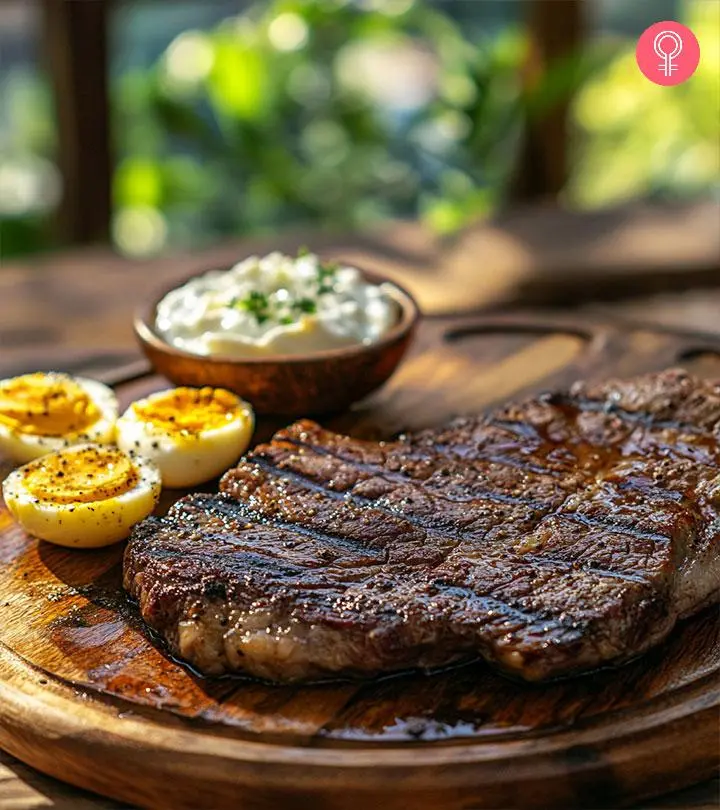
Image: Midjourney/ StyleCraze Design Team
No protein, no life! It is as simple as that. Protein-rich foods are essential for building muscles and performing a host of other functions in the body. So, it is important to figure out what these foods are and stocking up on them. What about you? Does your diet contain such foods?
If not, here is a list of the 48 foods rich in protein. Include them in your diet and enjoy the benefits. Check them out below!
In This Article
What Is Protein?
Simply put, protein is a macronutrient required for building muscle mass. Chemically, protein is composed of amino acids.
When protein is broken down in the body, it fuels the muscle mass and contributes to metabolism. It also enhances immunity.
Which is why it is important.
A survey conducted on 1825 older adults in the European Union found that 12.2% had a poor appetite and low protein intake, 25.5% had a good appetite but low protein intake, 14.*% had a poor appetite and high protein intake, and 47.5% had a good appetite and high protein intake.
Alright. But which foods are good sources of protein? That is where we are heading to right now.
Key Takeaways
- Proteins boost immunity and build muscle mass.
- Eggs, milk, oats, and Greek yogurt are good sources of protein.
- Walnuts, pumpkin seeds, cashews, and chia seeds are foods high in protein.
- A protein deficiency may cause anxiety, trouble falling asleep, and fatigue.
Top 48 High Protein Foods List
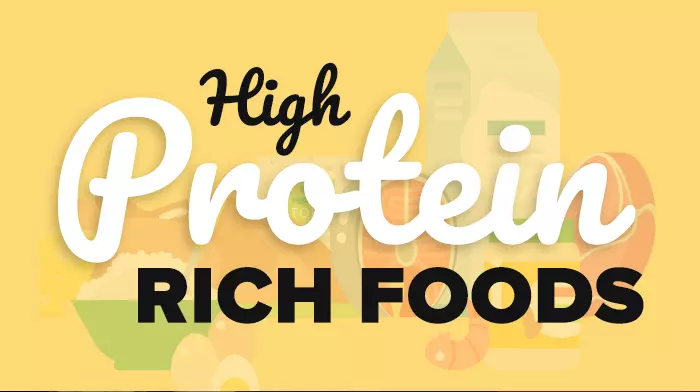
Protein is a powerhouse nutrient that is essential for building and repairing our bodies. Knowing where to find protein in the form of food can help you fuel your body effectively. From lean meats and fish to beans and lentils, there is a wide variety of options to choose from. Here is a list of the top 48 protein-rich foods organized by food groups eaten around the world.
Here we mention some of the best protein rich foods that you should put on your grocery list!
- Eggs
- Almonds
- Chicken Breast
- Cottage Cheese
- Greek Yogurt
- Oats
- Milk
- Broccoli
- Tuna
High Protein Dairy And Eggs
Let us quickly look at the top dairy products high in protein.
1. Swiss Cheese
1 slice of Swiss cheese contains 7.5 grams of protein and 106 calories (meets 15% of your daily protein requirement) Swiss cheese also contains other nutrients that can benefit your bones, eyes, and the immune system.
Also, it is low in potassium – and hence, kidney patients can enjoy this cheese. Another form of cheese, goat cheese, contains 7 grams of protein for an ounce.
How To Include In Your Diet
You can simply add a slice of Swiss cheese to your bowl of soup or a sandwich.
2. Cottage Cheese
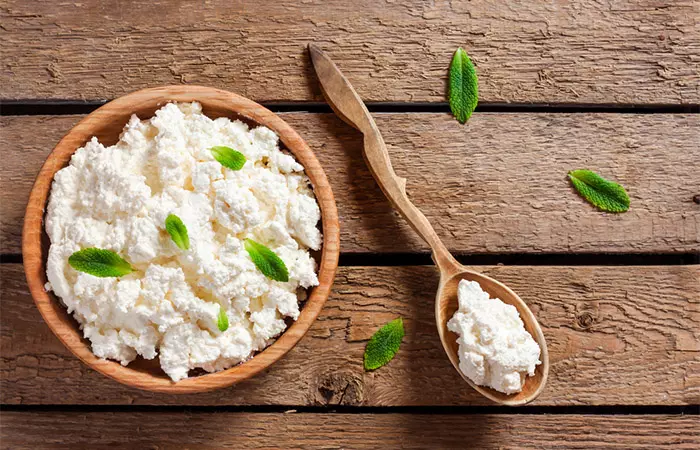
1 cup of cottage cheese contains 28 grams of protein and 163 calories (meets 56% of your daily protein requirement)
Each half cup of cottage cheese contains 13 gm of proteins. It is a great, inexpensive, and healthy food item. In addition to providing protein for muscles, cottage cheese contains calcium for good bones. You can combine it with protein-rich vegetables or fruit to make a great dish. Other forms of cheese also have good amounts of protein. It is best taken in its low-fat version. Also, cottage cheese is as satiating as eggs – and could be a good option for weight loss (1).
Additionally, Parmesan cheese (1 tablespoon – 4% of daily value) , cheddar (1 slice – 14% of daily value), and mozzarella (6 slices – 75% of daily value) are also rich in protein.
How To Include In Your Diet
You can relish cottage cheese in so many ways. Add it to your toast. Or to your fruit or vegetable salad. You can even enjoy it on its own.
3. Egg Whites
1 large egg white contains 3.6 grams of protein and 16 calories (meets 7% of your daily protein requirement)
Eggs are an excellent source of protein, particularly egg whites. Egg whites are low in cholesterol and high in protein. Egg whites are also low in fat, which makes them the perfect food for a healthy and nutritious breakfast. One cup of egg whites contains 26 grams of protein. This will also provide you with energy and essential amino acids. Adults are advised to eat one egg daily. And as per studies, egg white protein supplementation can increase resistance muscle strength – especially in females (2).
How To Include In Your Diet
You can make egg whites a part of your salad.
4. Tofu
¼ block of tofu contains 12.8 grams of protein and 117 calories (meets 26% of your daily protein requirement) Tofu is a great alternative to meat and is used in a variety of Indian dishes.
Apart from proteins, tofu is also rich in magnesium, iron, and other essential nutrients. Like other soy foods, tofu reduces heart diseases by lowering bad cholesterol and promoting good cholesterol.
How To Include In Your Diet
The best thing about tofu is it takes on the flavor of the foods you cook it with. So, you can replace beef or chicken with tofu in a stir-fry.
5. Greek Yogurt
2/3 cup of Greek yogurt contains 11 grams of protein and 130 calories (meets 22% of your daily protein requirement) Apart from protein, Greek yogurt also contains calcium and vitamin B12.Talking about calcium
, your body cannot produce the mineral on its own. Hence, you need to take it externally. Calcium is great for the bones. And vitamin B12 is required for the formation of red blood cells and brain functioning. According to ongoing studies, Greek yogurt could also have a favorable effect on the gut bacteria (3).
How To Include In Your Diet
Simply have Greek yogurt at the end of your meal.
 Quick Tip
Quick Tip6. Soy Milk
1 cup of soy milk contains 8 grams of protein and 131 calories (meets 16% of your daily protein requirement)
Soy milk is another great option for vegetarians to get a good dose of proteins. Adding this super drink to your diet will provide you with the recommended daily allowance of protein needed by an individual. Studies also show that the intake of soy milk can reduce the risk of osteoporosis (4).
Even 1 cup of whole milk has 8 grams of protein, and comes with 149 calories.
How To Include In Your Diet
Add soy milk to your breakfast cereal.
High Protein Meats
Animal proteins have all the essential amino acids that are required in a diet. The Food and Agriculture Organization of the United Nations noted that 133 million tons of poultry were consumed in 2021 alone. The graph below divides the animal proteins by source.

Estimated animal protein consumption worldwide in 2021
Source: Estimated animal protein consumption worldwide in 2021These best protein sources pack a major protein punch.
7. Steak (Ground Beef)
1 ounce of ground beef contains 7.6 grams of protein and 76 calories (meets 15% of your daily protein requirement)
Steak is especially rich in amino acids. These acids help prevent numerous muscle-wasting diseases. Simply put, they protect and build your muscles. Amino acids can also reduce blood pressure and strengthen the connective tissues (5).
A serving of ground beef (85 grams) contains about 23 grams of protein, which is 45% of the daily value. While a 3 oz serving of roast beef contains 18 grams of the nutrient, 1 oz serving of beef jerky (lean beef meat trimmed of fat and cut into strips) contains 13 grams of protein.
How To Include In Your Diet
Simply include cut steak pieces in your salad. You can also go for beef stock soup.
8. Pork Chops

1 pork chop (top loin and boneless) contains 39 grams of protein and 286 calories (meets 77% of your daily protein requirement)
Pork chops are excellent sources of zinc as well. This mineral is essential for performing numerous reactions in your body. And the deficiency of zinc can lead to night blindness and a weakened immune system. Canadian bacon, another form of pork, contains 15 grams of protein for every 3 oz serving. And chorizo, a spicy Spanish pork sausage, has 21 grams of protein for every 3 oz serving. While pepperoni contains 18 grams of the nutrient for the same amount of serving, a slow-roasted pork loin contains 28 grams of protein for every 3 oz serving.
How To Include In Your Diet
You can serve pork chops with salad or cooked vegetables. You can also braise them with mushroom sauce and eat with brown rice.
9. Turkey Breast
1 slice of turkey breast contains 4 grams of protein and 22 calories (meets 7% of your daily protein requirement)
Apart from being one of the best high protein foods, turkey breast can also make you feel full for long periods. The breast of turkey has less fat and calories than most other cuts of meat. And it contains selenium, which can help prevent a range of cancers.
How To Include In Your Diet
Keep in mind to avoid processed turkey. You can opt for fresh, lean, organic turkey. And just like that of chicken, you can include turkey breast in your evening meal.
10. Chicken Breast
½ a chicken breast contains 28 grams of protein and 142 calories (meets 53% of your daily protein requirement)
Intake of poultry has numerous benefits for people of all age groups and conditions. It is especially beneficial for individuals who have a higher protein and calorie need (6).
While using chicken breast, instead of tossing the bones away, you can use them to prepare bone broth. This is another food that is rich in protein (¼ cup contains 20 grams of the nutrient).
Or you might as well go for canned chicken too. A 3 oz serving contains 21 grams of protein.
How To Include In Your Diet
You can divide your plate evenly between whole grains, fruit, vegetables, and chicken breast – for your evening meal.
High Protein Seafood
Below is a list of high protein foods that fall under the seafood category.
11. Halibut
½ a filet of halibut (Atlantic and Pacific) contains 42 grams of protein and 224 calories (meets 85% of your daily protein requirement)
Oily fish like halibut are rich in omega-3 fatty acids, which are known to reduce the risk of heart disease and lower cholesterol levels. Halibut is also low in saturated fat, the unhealthy kind of fat.
How To Include In Your Diet
Enjoy the fish baked or grilled and not fried. You can go for low-salt and low-fat seasonings like lemon, herbs, and spices.
12. Sardines
1 small sardine contains 3 grams of protein and 25 calories (meets 6% of your daily protein requirement)
The omega-3 fatty acids in sardines reduce the risk of inflammation and cardiovascular disease. Other important nutrients sardines are rich in are selenium (to prevent oxidative damage to the body) and vitamin B12 (for nerve function and brain health). Sardines also have vitamin D that facilitates bone health.
How To Include In Your Diet
Simply add chopped sardines to your salad.
13. Pacific Cod Fish
1 filet of Pacific cod fish contains 21 grams of protein and 95 calories (meets 42% of your daily protein requirement)
The upside about cod, apart from being a superb source of protein, is that it contains very less fat. And more of the heart-healthy mono and polyunsaturated fats. The vitamins D and B12 regulate bone health and improve nerve functioning respectively.
How To Include In Your Diet
Cook cod right on top of fresh green beans along with a flavorful sauce for a delicious treat.
14. Anchovies
1 ounce of anchovies (European) contains 5.7 grams of protein and 37 calories (meets 11% of your daily protein requirement)
In addition to protein, anchovies are also rich in magnesium, calcium, and phosphorus – all of which are imperative to bone development and maintenance. Calcium also supports cardiovascular functioning. It stimulates the blood vessels in the heart, while magnesium makes them relax. The two, in unison, maintain heart health and blood pressure.
How To Include In Your Diet
Anchovies are usually purchased in cans – and though canned anchovies are not nutritionally deficient, they contain excess sodium that can be harmful. Hence, choose fresh anchovies. You can add sautéed and grilled anchovies to pasta and tomato sauce.
15. Octopus
1 ounce of octopus contains 4.2 grams of protein and 23 calories (meets 8% of your daily protein requirement)
Like all seafood, the octopus is lean and low in calories. One downside is cholesterol – it is high in it. So, practice moderation. Otherwise, it is naturally rich in iron – the mineral required for the transport of oxygen to different parts of the body. Iron also plays a major role in cell growth. And the selenium in octopus acts like an antioxidant and prevents damage by free radicals.
Another nutrient it contains is vitamin B12 that supports brain function.
Even shrimp contains a decent amount of protein, with a 3 ounce serving having 18 grams of protein (and 84 calories).
How To Include In Your Diet
Ensure you thoroughly clean the octopus before cooking it. You can then sauté octopus chunks and simmer them in seafood stock. You can also add onions and bay leaves to the pan and season with salt and pepper. Drizzling the dish with lemon juice before serving adds an extra punch.
16. Yellowfin Tuna (Or Light Tuna)
1 oz of boneless tuna contains 6.6 grams of protein and 31 calories (meets 13% of your daily protein requirement)
The tuna is also rich in B vitamins that aids nerve functioning and blood circulation. This food is a low-calorie and low-cholesterol protein source.
One serving of light tuna (154 grams) contains about 39 grams of protein. It makes up for 79% of the daily value.
How To Include In Your Diet
Using your skillet, you can prepare grilled fish. It will taste delicious.
17. Alaskan Salmon
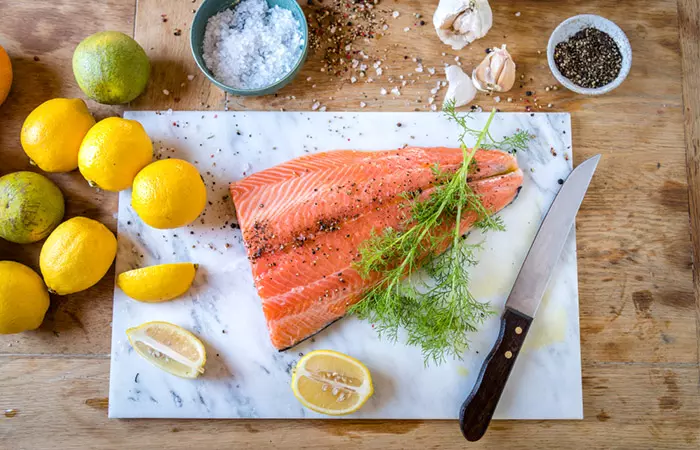
1 ounce of Alaskan salmon contains 6.3 grams of protein and 39 calories (meets 13% of your daily protein requirement)
Salmon is a powerhouse of nutrition. It greatly contributes to the overall health. The omega-3s reduce inflammation and help treat joint pains. They also aid neurological repair and heart health. And also, salmon can promote skin health.
According to a report by the Washington State Department of Health, salmon fish can help treat abnormal heart rhythms and strokes (7).
You can also take wild-caught salmon (and other wild fish) as it also is rich in protein. The protein content is similar to that of Alaskan salmon. Or even take sockeye salmon – where a 3 oz serving contains 23 grams of protein.
How To Include In Your Diet
Add smoked salmon to your pasta along with cream.
18. Tilapia
1 ounce of tilapia contains 4.2 grams of protein and 27 calories (meets 8% of your daily protein requirement)
Apart from being one of the protein rich foods, tilapia also contains omega-3 fatty acids (whose benefits we have seen). It is a good source of calcium as well, which, apart from building strong teeth and bones, also works with potassium to enhance nervous system function.
How To Include In Your Diet
You can cook tilapia with anything. It is very low in carbohydrates. Simply add it to your salad or slather it with your favorite sauce.
High Protein Seeds And Nuts
Check out here the best sources of protein in the nuts and seeds category, that you will surely want to add into your diet.
19. Peanut Butter
2 tablespoons of peanut butter contain 7.7 grams of protein and 188 calories (meets 15% of your daily protein requirement)
Two spoons of peanut butter, and you are set for the day with 8 grams of protein. The traditional toast can be flavored with this all-time favorite. You can also add peanut butter to protein shakes or smoothies. Either way, it’s a tasty vegetarian option to consume plenty of proteins. Consumption of peanut butter was also found to reduce the risk of type 2 diabetes (8).
You can as well add peanuts to your diet too, as one ounce of them contains 7 grams of protein (along with 159 calories).
How To Include In Your Diet
Did you know that most fruits taste delicious with peanut butter? Yes – add a helping of peanut butter to the bowl of fruit that you have every evening. And if you don’t have a bowl of fruit every evening, start doing so. It’s healthy.
20. Pistachios
1 cup of pistachios contains 25 grams of protein and 685 calories (meets 51% of your daily protein requirement)
Pistachios are good sources of fiber, which promotes digestive health. Fiber can also encourage satiety – consequently preventing overeating and aiding weight loss. Pistachios are also high in folate that is good for pregnant women.
They are nutrient-dense and possess antioxidant compounds that are wonderful for health (9).
How To Include In Your Diet
Add pistachios as toppings to your yogurt or salad. Simple.
21. Quinoa
1 cup of the seeds contains 24 grams of protein and 626 calories (meets 48% of your daily protein requirement)
The seeds contain plant compounds quercetin and kaempferol, which possess anti-inflammatory and anticancer properties.
How To Include In Your Diet
Boil raw quinoa seeds with a dash of salt and have them as an evening snack.
22. Almonds
10 almonds contain 5.9 grams of protein and 161 calories (meet 12% of your daily protein requirement)
Almonds are known to reduce cancer risk and heart disease. They also help lower cholesterol levels. Also, the nuts are known to cut diabetes risk (10).
How To Include In Your Diet
Almonds can be added to salads and other dishes for extra flavor. You can add them to your favorite smoothie as well.
 Quick Tip
Quick Tip23. Walnuts
1 cup of chopped walnuts contains 18 grams of protein and 765 calories (meets 36% of your daily protein requirement)
Regular intake of walnuts can help prevent gallstones. They are also a good source of copper that improves bone mineral density and prevents osteoporosis. And walnuts also contain magnesium that can help combat epilepsyi Central nervous system disorder characterized by seizures, unconsciousness, or odd behavior due to brain activity fluctuations. .
Walnuts also contain polyphenolic compounds that reduce the inflammatory load on the brain cells and enhance interneuronal signaling (11).
How To Include In Your Diet
Top your salads or yogurt with walnuts.
24. Pumpkin Seeds
1 cup of the seeds contains 12 grams of protein and 285 calories (meets 24% of your daily protein requirement)
The seeds are also rich in zinc that enhances immunity. This very zinc even improves prostate health and prevents prostate cancer in men. Pumpkin seeds can also improve insulin regulation, thereby preventing diabetes.
Other seeds rich in protein include flaxseeds (1 cup – 61% of daily value) and sunflower seeds (1 cup – 58% of daily value).
How To Include In Your Diet
You can eat the seeds on their own. Or you can use them as a topping for your salad.
25. Pecans
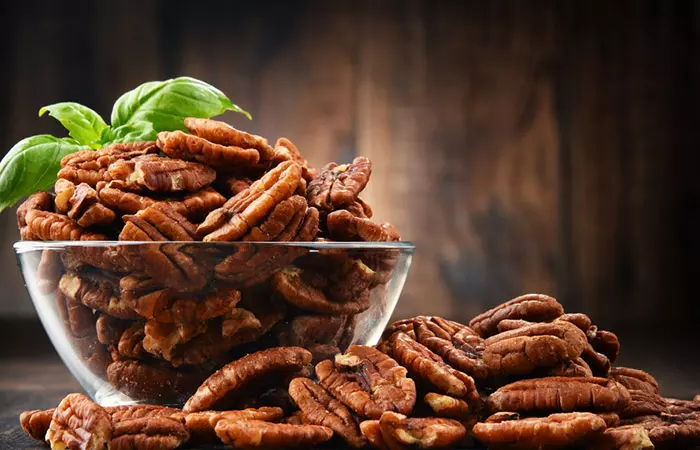
1 cup of chopped pecans contains 10 grams of protein and 753 calories (meets 20% of your daily protein requirement)
Pecans contain healthy fats that contribute to weight maintenance. They are rich in antioxidants, which makes them an ideal food to beat oxidative stressi A condition caused by an imbalance between the creation and buildup of oxygen radicals in cells and the ability to detoxify them. .
Pecans also stimulate hair growth, reduce stroke risk, and improve digestive health (12).
How To Include In Your Diet
You can simply have roasted pecans as an evening snack.
26. Hemp Seeds
1 ounce of hemp seeds contains 9.2 grams of protein and 161 calories (meets 18% of your daily protein requirement)
Hemp is the next best product for those allergic to soy-based offerings. This plant derivative provides you with many essential amino acids that the body uses to build muscle. Hemp dairy products and hemp seeds contain fatty acids that greatly improve the immune system.
How To Include In Your Diet
You can have a handful of the shelled seeds, toasted or as they are, as a nutritious evening snack.
27. Cashews
1 ounce of cashews contains 5.1 grams of protein and 155 calories (meets 10% of your daily protein requirement)
The copper and iron in cashews aid the formation of red blood cells. This, in turn, keeps the entire system functioning optimally. Cashews are also exceptionally good for your eyes. They are an excellent source of magnesium, a mineral that is required for body processes (13).
Intake of cashews has also been linked to cancer prevention and weight maintenance.
How To Include In Your Diet
You can add a handful of cashews to your evening smoothie and enjoy the tasteful delight.
28. Chia Seeds
1 ounce of chia seeds contains 4.4 grams of protein and 137 calories (meets 9% of your daily protein requirement)
They are rich in fiber and omega-3s and offer a host of benefits (14). The seeds also offer a superb energy boost. They deliver a massive amount of nutrients with few calories.
Chia seeds also improve certain blood markers, which can cut the risk of heart disease and type 2 diabetes.
How To Include In Your Diet
Adding chia seeds to your smoothie is one of the best ways to consume them.
High Protein Grains And Legumes
Here are top foods rich in protein in the grains and legumes section.
29. Soybeans
1 cup of soybeans contains 68 grams of protein and 830 calories (meets 136% of your daily protein requirement)
Often hailed as the most protective bean, soybean has the highest protein content amongst all plant sources. It is also the only plant food containing all the essential amino acids. It contains omega-3 fatty acids that prevent cardiovascular disease and some forms of cancer. And the fiber in the bean promotes digestive health.
Soybean is also rich in iron and calcium that are required for optimum health.
Another food is natto, a popular Japanese breakfast option that is nothing but fermented soybeans. ½ a cup of natto contains 15 grams of protein.
Edamame, yet another Japanese soybean dish (salted green soybeans boiled in their pods), contains 8 grams of protein for every ½ cup serving.
And tempeh, an Indonesian dish prepared by deep-frying fermented soybeans, contains 16 grams of protein for every ½ cup serving.
How To Include In Your Diet
One simple way is to go for soymilk, which you can easily find on supermarket shelves. You can even add soy cream to your morning tea or coffee. Or best, you can simply replace in your bread or muffin recipes with soy yogurt.
30. Lentils
1 tablespoon of lentils contains 3.1 grams of protein and 42 calories (meets 6% of your daily protein requirement)
Given they are rich in folic acid, fiber, and potassium – lentils are great for heart health. The folic acid is also critical during pregnancy – it was found to cut the chances of early delivery by as much as 50%, and it also reduces the risk of birth defects in newborns. Lentils also fight fatigue as they are rich in iron.
Even Ezekiel bread can be a good option. This is often considered the healthiest form of bread one can eat. It contains several types of grains (like wheat, barley, and millet) and legumes (like lentils and soybeans). 1 slice of Ezekiel bread contains 4 grams of protein and has 80 calories.
How To Include In Your Diet
You can add lentils to any kind of soup for added fiber and nutrients.
31. Kidney Beans
1 tablespoon of kidney beans contains 1 gram of protein and 14 calories (meets 2% of your daily protein requirement)
The beans are rich in vitamin B1 that improves memory. The vitamin can also prevent Alzheimer’s. Kidney beans also contain molybdenum that detoxifies the body. Even black beans, navy beans, and other kinds of beans are rich in protein – 1 cup of them contains 15 grams of the nutrient.
And by the way, bean chips, the favorite snack for many, contain protein too – 4 grams of protein for every oz serving.
How To Include In Your Diet
You can combine the beans with your soups or salads.
32. Wheat Germ
1 cup of wheat germ contains 27 grams of protein and 414 calories (meets 53% of your daily protein requirement)
Wheat germ is also rich in vitamin E, an antioxidant that fights free radicals. Other nutrients it is rich in include zinc, magnesium, potassium, and thiamin.
How To Include In Your Diet
A dose of wheat germ in your yogurt or smoothie can do the trick.
33. Oats
1 cup of oats contains 26 grams of protein and 607 calories (meets 53% of your daily protein requirement)
In addition to protein, oats are also good sources of soluble fiber – which can help prevent coronary heart disease (15). They also improve digestion and prevent colorectal cancer.
How To Include In Your Diet
You can thicken your smoothie with a spoonful of oats. Or better, mix oats, yogurt, grated apple, and a pinch of cinnamon – leave them overnight in the fridge, and the next morning, you can have a super powerful breakfast.
34. Barley
1 cup of barley contains 23 grams of protein and 651 calories (meets 46% of your daily protein requirement)
Being rich in fiber, barley aids digestion and weight loss and helps control blood sugar and cholesterol. It also offers protection against cancer.
How To Include In Your Diet
You can simply consume whole grain bread that contains barley. Or cook it to make hot cereal. Barley can also be added to stuffings and enjoyed.
35. Chickpeas
1 cup of chickpeas contains 15 grams of protein and 269 calories (meets 29% of your daily protein requirement)
Chickpeas are a form of complex carbohydrate that the body slowly digests for energy. This helps control blood sugar levels. Being rich in protein and fiber, chickpeas increase satiety. This discourages overeating and, in turn, aids weight loss. The high fiber also improves digestion and prevents any digestive ailments.
Another chickpea dish, called falafel, contains about 3 grams of protein per serving. And ½ a cup of hummus, made from ground chickpea and sesame seeds, along with olive oil, garlic, and lemon, contains 6 grams of protein.
How To Include In Your Diet
You can add chickpeas to your salad.
36. Soba Noodles
1 ounce of the noodles contains 4 grams of protein and 94 calories (meets 8% of your daily protein requirement)
Soba noodles are also a great source of manganese that improves glucose metabolism and the nervous system. It even accelerates wound healing. It is also rich in thiamin, the deficiency of which can cause muscle weakness and confusion.
How To Include In Your Diet
You can make your own soba noodles and add a few veggies like spinach, mushrooms, and carrots for that extra punch of nutrition.
37. Green Peas
1 cup of green peas contains 9 grams of protein and 134 calories (meets 17% of your daily protein requirement)
Green peas are rich in numerous other nutrients, including iron, copper, zinc, calcium, manganese, and vitamin K – all of which promote numerous bodily functions. They also prevent brain damage that can otherwise cause Alzheimer's diseasei A brain disorder that becomes worse over time and shrinks and kills brain cells, resulting in dementia, confusion, and memory loss. .
The fiber in peas contributes to gastrointestinal health (16).
How To Include In Your Diet
Simply add raw peas to your salad.
38. Brussels Sprouts
1 cup of the sprouts contains 3 grams of protein and 38 calories (meets 6% of your daily protein requirement)
Brussels sprouts come packed with vitamins, minerals, fiber, and proteins. These sprouts also contain some essential organic compounds that have potent anticancer properties.
How To Include In Your Diet
You can slice the sprouts thin and mix them raw with salad greens.
High Protein Fruits And Vegetables
Below is a list of foods with the highest protein rich fruits and vegetables.
39. Broccoli
1 broccoli stalk contains 4.3 grams of protein and 51 calories (meets 9% of your daily protein requirement)
One of the best high protein vegetables, Broccoli has been touted as one of the best foods to fight cancer. Given it is replete with phytochemicals, it works as a great anticancer food (17). And the vegetable is also a great source of fiber, especially soluble fiber (which helps regulate blood glucose and cholesterol and prevents diabetes and heart disease).
Broccoli is also an excellent source of vitamin K that enhances bone health (as vitamin K improves calcium absorption).
How To Include In Your Diet
You can simply add half a cup of broccoli to your daily meal. You can also consume raw broccoli salads.
40. Asparagus
1 cup of asparagus contains 3 grams of protein and 27 calories (meets 6% of your daily protein requirement)
Another good thing about asparagus is it can prevent urinary tract infections. The amino acid asparagine this veggie contains makes it a natural diuretic. It also contains vitamin E that boosts and improves skin health.
And yes, it works as a natural aphrodisiac – thanks to folate and vitamin B6, this vegetable can boost feelings of arousal.
How To Include In Your Diet
An advantage with asparagus is you may not have to season it – it has a distinct flavor. One easy way to use this vegetable is steaming it or using it raw in a yogurt dip.
41. Sweet Corn
1 large corn ear contains 4.6 grams of protein and 123 calories (meets 9% of your daily protein requirement)
An upside is that sweet corn is pretty low in fat. And that’s good news. The vegetable is also rich in potassium and vitamin A. Potassium is usually lost through sweat, and hence, regularly replenishing the mineral is important – as it contributes to heart health and bone strength. Vitamin A works as an antioxidant.
The vegetable is rich in fiber as well – the benefits of which we already know.
How To Include In Your Diet
Sweet corn can make an awesome addition to soups. You can also add it to your salads and casseroles.
42. Cauliflower
1 large cauliflower head contains 16.6 grams of protein and 210 calories (meets 33% of your daily protein requirement)
Another important nutrient cauliflower is rich in is choline. This nutrient enhances memory and learning, improves sleep, and helps with muscle movement. Choline also aids in the transfer of nerve impulses and assists in fat absorption.
The vitamin K in the vegetable promotes stronger bones. Cauliflower also has a high fiber and water content, which prevents constipation and reduces the risk of colon cancer.
How To Include In Your Diet
A unique way to include cauliflowers in your diet is by mashing them, just like potatoes. And then add garlic and cheese to the dish – you won’t leave it.
You can also add cauliflower to a vegetable salad (along with a serving of mushrooms, which contains 4 grams of protein).
43. Apricots
1 apricot contains 0.5 grams of protein and 17 calories (meets 1 % of your daily protein requirement)
Apart from potassium and fiber, apricots are also rich in non-heme iron (the type of iron found in plants). A diet rich in iron can prevent anemia. Also, non-heme iron is not as easily absorbed as heme iron. Which is why you should take apricots along with a source of vitamin C (vitamin C enhances iron absorption).
How To Include In Your Diet
Diced apricots could be a great addition to your evening salad.
44. Tangerine
1 large tangerine contains 1 gram of protein and 64 calories (meets 2% of your daily protein requirement)
Tangerines are loaded with flavonoids, compounds that contain anticancer properties. These neutralize the free radicals that cause diseases and can prevent heart disease. Flavonoids might also improve blood flow in the coronary arteries.
The folate in tangerines maintains the health of new body cells. Also, the potassium in the fruit helps fight osteoporosis.
How To Include In Your Diet
You can consume tangerines as a healthy evening snack. Or slice them and add to a salad and relish.
45. Coconut
1 medium coconut (the meat) contains 13.2 grams of protein and 1405 calories (meets 26% of your daily protein requirement)
Both coconut water and coconut pulp are highly nutritious. Coconut water offers an array of health benefits and is highly recommended, especially during the summer season.
Raw coconut is also rich in medium-chain triglycerides – which can aid weight loss. A single serving of coconut meat offers several minerals, and including it in your diet invariably increases its nutritional value. And several substances in coconut can help boost your immunity.
How To Include In Your Diet
Do not throw away the shell after drinking the water as the soft pulp of the tender coconut is equally rich in proteins. The pulp tastes extremely delicious. You can either have it raw or add it to salads. Coconut milk is also rich in proteins and healthy fats.
46. Banana
1 large banana contains 1.5 grams of protein and 121 calories (meets 3% of your daily protein requirement)
Bananas are also very good sources of potassium. They relax the walls of the blood vessels and lower blood pressure. The fruit can also be a good food to be taken during diarrhea – as electrolytes like potassium are lost during diarrhea, and banana helps replenish the mineral.
Bananas, being rich in fiber, can prevent heart disease and diabetes. They are also rich in amino acids and can be used as face packs to treat dry skin.
Your morning breakfast smoothie can be rich in protein too – as every 1 cup serving contains 16 grams of the nutrient.
How To Include In Your Diet
You can add chopped bananas to your breakfast porridge. Smoothies or milkshakes of the fruit are equally delicious and healthful.
47. Avocados
1 avocado contains 4 grams of protein and 322 calories (meets 8% of your daily protein requirement)
The fruit is rich in folate, which is an essential nutrient during pregnancy. It reduces the risk of miscarriages and ensures a healthy delivery. Avocados also prevent the build-up of homocysteine, a substance that can contribute to depression by impairing circulation and the delivery of nutrients to the brain.
Avocado consumption also improves heart health (18).
How To Include In Your Diet
You can replace butter with avocado on your morning toast. Or, if you are having chicken or egg salad, you can use this fruit in place of mayonnaise.
48. Guavas
1 guava contains 1.4 grams of protein and 37 calories (meets 3% of your daily protein requirement)
Being rich in fiber, guavas enhance digestive health and prevent related disorders. They are rich in vitamin C as well that boosts immunity and skin health.
How To Include In Your Diet
You can eat the fruit or prepare its juice. Or add the fruit to a salad and enjoy.
Other fruits like pomegranates, grapefruit, and passion fruit contain about 2 to 5 grams of protein per cup.
Yevgeniy (Jim) Brikman, a blogger, lost 43 lbs in less than 8 months. According to him he followed 2 basic rules. First, the amount of calories you intake should be lesser than the calories you burn. And second, increase your protein consumption to lower your body fat percentage and maintain a lean body mass. He writes, “In any case, if you need to up your protein intake, you’ll probably need to rework your diet around foods that are high in protein, but relatively low in calories. One gram of pure protein has about 4 calories in it. For any given food, you can divide the number of calories it has by the grams of protein (i). ”
Are You Getting Enough Protein?
Because if you are not, it is bad news. Following are the signs of protein deficiency – you are not getting enough protein if
- You often feel anxious and moody. Protein contains amino acids that are the building blocks for neurotransmitters (they control your mood).
- Your workouts are not great. Protein is required to sustain your energy during workouts.
- You are unable to sleep well. Protein helps in the production of serotonin, low levels of which can cause sleep issues.
- You have high cholesterol despite following a proper diet. Cholesterol levels also rise due to hormonal imbalances and increased inflammation, which can be treated with adequate protein intake.
- You experience a lack of focus and concentration. Inadequate protein means inadequate amino acids, and that means decreased neurotransmitters (which help improve your concentration levels).
- Your menstrual cycle is irregular. This caused by a condition called polycystic ovary syndrome (PCOS). (It is, in a way, related to protein deficiency.)
- You get injured often and are slow to heal. As we know, protein is a body building food. Its deficiency can slow down the healing process.
- You feel fatigued often. Metabolic functions also depend on amino acid intake.
If you have any of these symptoms, it’s time to take some serious care. And by the way, how much protein should you consume?
Daily Recommended Dosage Of Protein
| Age Group | Required Amount Of Protein |
| Babies | 10 grams |
| School-age kids | 19-34 grams |
| Teenage boys and girls | 52 grams and 46 grams, respectively |
| Adult men and women | 56 grams and 46 grams, respectively |
Pregnant and breastfeeding women need about 71 grams of protein per day. These are approximate figures. The actual requirement might differ (in case the individual has any specific condition). The recommended daily intake (RDI) is 56 grams for men, and 46 grams for women.
Simply put, you need anywhere from 0.8 grams to 1.3 grams per kg of your body weight of protein every day.
How To Increase Protein Intake
Nothing to worry – by making simple changes to your diet and lifestyle, you can increase your protein intake. Here are a few ways:
- Replace cereal with eggs. Most breakfast foods, including cereals, are low in protein. But 3 eggs offer you 19 grams of high-quality protein.
- Go for Greek yogurt. Because it is a high-protein food. One serving of Greek yogurt gives you 20 grams of protein, which is double the amount offered by traditional yogurt.
- Have the protein first. This is because protein increases the production of a gut hormone called PYY that makes you feel full. This also discourages you from downing unwanted calories.
- Use almonds to top your food. Apart from magnesium and vitamin E, they are also high sources of protein. They add flavor and crunch to your meal.
- Take a protein shake for breakfast. Protein powders can do the job. Though smoothies contain lot of fruit, they may contain less protein. You can add one scoop of protein powder and enjoy the shake along with your nutritious breakfast.
- Have a high-protein food with every meal. Include high protein food sources (you have seen some of them in this article) in every meal of yours.
- Peanut butter with fruit is a good combination. Fruit alone can sometimes be low in protein. But pairing it with peanut butter can pack a nutritious punch.
Although protein provides many health benefits, excess consumption may potentially lead to some health issues. Find out more in the next section.
Can You Eat Too Much Protein?
Yes, though rare, it is possible that one could eat too much protein.
- Kidney Issues:Excess protein intake may negatively affect kidney function and increase the risk of kidney stones (19).
- Reduced Bone Health:High protein diets may lead to increased calcium loss (20). While this usually may not impact bone health, there could be a risk in some cases.
- Digestive Discomfort:Anecdotal evidence suggests that overconsumption of protein may cause constipation and diarrhea.
It is essential to know the recommended protein intake to minimize these negative effects. Check out the section below for expert recommendations on protein intake.
10 Experts Reveal Their Secrets On Best Protein-Rich Foods
To help our readers know more about food high in protein, we have conducted an expert roundup to give the best ideas. The insights we received from the eminent nutrition experts and dietitians on protein sources are as stated below:
1. Natalie Jill
- Whey Protein: This could be mixed with water or unsweetened almond milk and drunk alone pre and post workout. Or, it can be blended into a smoothie with some fruit and nut butter as a great meal replacement. Whey protein is fast absorbing, great for pre and post workout and also helps to suppress appetite!
- Greek Yogurt: Greek yogurt is a favorite of mine! Loaded with protein, it has lesser sugar than traditional yogurts. Its thick texture makes it very rich-tasting. I love to mix mine with mixed berries and a few sprinkled sliced almonds
- Turkey Bacon: Nitrate-free, organic and free range. Rich in protein, it has a strong, yummy flavor and crunch. It can be chopped up and added to salads for an extra punch. Another favorite way to eat this is wrapped around grilled shrimp.
Natalie Jill:NatalieJillFitness.com
2. Cynthia Pasquella
- Hemp: Hemp is considered to be one of nature’s most perfect foods. The protein found in hemp, along with fiber, helps slow digestion, so you don’t get a huge spike in your blood sugar. It will also keep you feeling full longer. Hemp protein is considered to be a complete protein which means it contains all the nine essential amino acids needed to meet our body’s needs.
- Quinoa: Like hemp, quinoa is also considered to be a complete protein. In just one cup of cooked quinoa, you can get more than 8 grams of protein! Quinoa also contains more protein than rice, millet, and wheat.
- Beans: In just more than one cup of beans, you can get about the same amount of protein as you would in a piece of chicken. Beans have what meat lacks – they contain phytochemicals, compounds only found in plants. They are high in antioxidants, a type of phytochemical, that prevent free radicals in the body.
Cynthia Pasquella:cynthiapasquella.com
3. Christine
- Omega-3 cafe free egg white
- Chilean sea bass
- Free range smoked turkey – thinly sliced at my favorite deli (Bristol Farms)
- Soy milk
Christine:christineavanti.com
4. Joy McCarthy
- Fish, chicken, and eggs
- Plant-based proteins: Chia, Quinoa, hemp seeds, and leafy greens
Joy McCarthy:https://www.joyoushealth.com/
5. Amie Valpone
- Chia seeds
- Flax seeds
- Hemp seeds
Amie Valpone:thehealthyapple.com
6. Danielle Omar
The protein foods I most commonly recommend to my clients are
- Greek yogurt
- Lentils
- Eggs!
Danielle Omar:foodconfidence.com
7. Carolyn Scott
- Spinach
- Quinoa
- Tempeh
Carolyn Scott:healthyvoyager.com
8. Lisa Defazio
Animal protein sources are complete proteins and will be used more quickly and efficiently by the body. My top picks are:
- Eggs: They are easy to prepare, inexpensive, versatile; you can eat them as a snack or meal, make veggie omelets, hard boil an egg for a snack, throw hard boiled eggs in a green salad, and my favorite, egg salad.
- Tuna: Cheap and versatile. I mix a can of water-packed tuna with light mayo, diced celery, dill, red onion; keep in the refrigerator for a light snack or lunch.
- Sliced Turkey Breast: Easy and quick, no cooking needed. Great for a quick lunch or snack!
Top vegetarian protein sources
- Nuts: They are satisfying; contain healthy fats, great for snacks and in salads.
- Beans: Toss in salads, I love hummus as a sandwich spread and a veggie dip.
Lisa Defazio:lisadefazio.com
9. Rosanna Davison
The three protein-rich foods that I recommend to clients are all plant-based because current research shows that a whole food plant-based diet is the best protection against lifestyle diseases. Many plant foods also contain fiber, omega-3 fats, antioxidants, and other essential nutrients that animal protein foods lack and they don’t contain cholesterol or saturated fat.
- I suggest to my clients that they eat quinoa regularly, which is a great source of complete protein, plus fiber, iron, and magnesium. It is extremely versatile.
- Lentils are my second choice as they also contain all essential amino acids, important minerals, and fiber.
- Hemp seeds are my third favorite source of protein as they have a perfect ratio of omega-6 to omega-3 fats and are a highly bioavailable source of complete protein.
Rosanna:rosanna.ie
10. Matt Fitzgerald
I’m not a big fan of “best” lists, because I believe that one of the best things we can do as eaters is eat diversely. So I will give you a diverse selection of healthy, protein-rich foods I like:
- Yogurt (dairy)
- Quinoa (grain)
- Lamb (meat)
Matt Fitzgerald:mattfitzgerald.org
Infographic: Interesting Facts About Protein
Protein is one of the main macronutrients required for building muscle mass in your body. Additionally, it contributes to immunity and metabolism, among other essential bodily functions. Foods like meat, fish, eggs, avocados, legumes, and nuts are rich in protein. We have compiled a list of interesting facts about proteins you should know. Check out the infographic below to know more! Illustration: StyleCraze Design Team
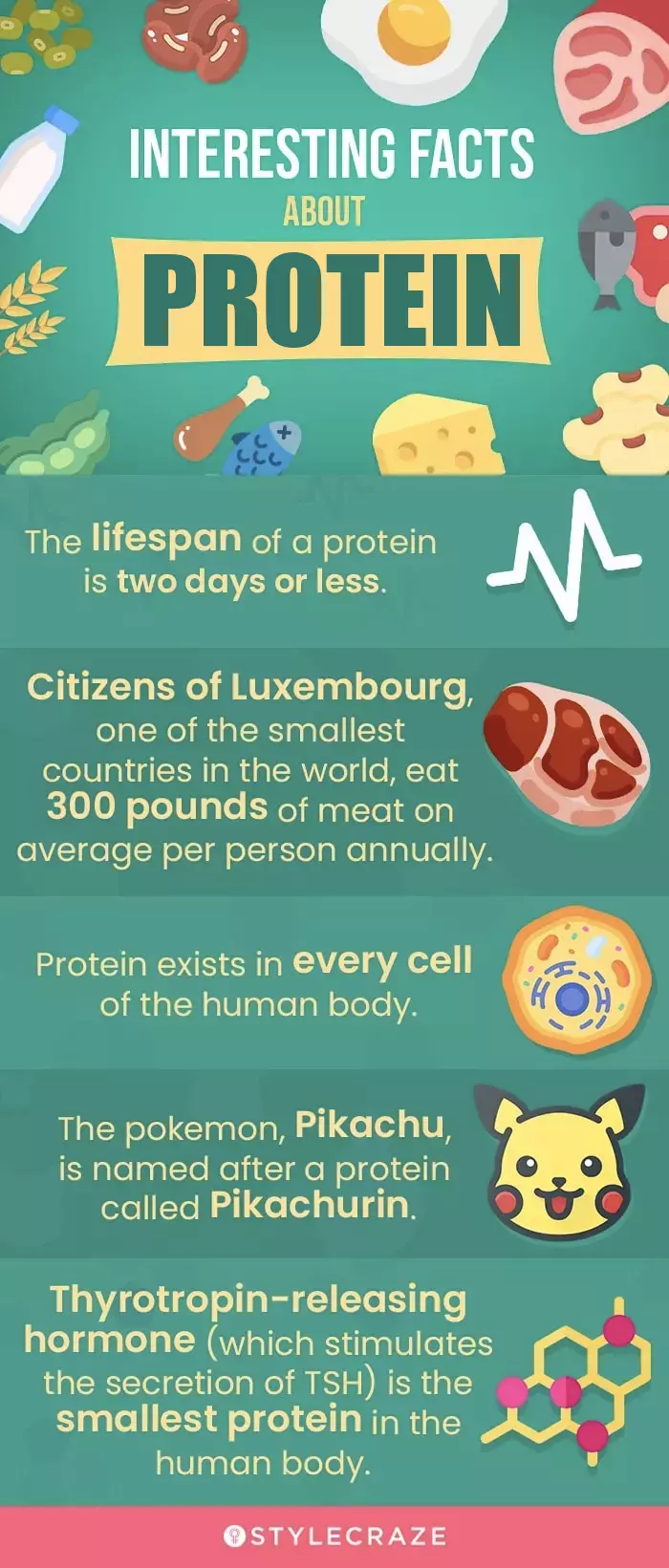
Protein is an essential macronutrient that helps you gain muscle mass and aid in processes like metabolism. It is found abundantly in meat, seafood, dairy, poultry, fruits, vegetables, nuts, seeds, legumes, and grains. Add these high-protein foods and protein supplements like protein bars to your diet to meet your daily recommended levels of this macronutrient and stay healthy. A protein deficiency often manifests in the form of poor focus/concentration, sleep issues, irregular menstrual cycle, anxiety, defective wound-healing, fatigue, etc. So, adult men and women must get at least 56 g and 46 g of protein, respectively. However, pregnant and lactating women need 71 g of protein daily.
Frequently Asked Questions
How much protein is too much?
Too much of protein can cause body fat. It can also cause damage to the kidneys.
Which foods with high protein are good for pregnancy?
Beans, lean meat, eggs, cheese, poultry, and yogurt. Other protein sources mentioned in this post would suffice too.
Should women avoid soy protein?
Women who are undergoing hormonal therapy or have breast cancer (estrogen-receptor-positive) must avoid soy protein and soy-based supplements as they contain isoflavones. Women with any other medical condition must consult their doctor once before taking soy protein.
Can I take protein infrequently instead of daily?
Doing so may not give you the amount of protein you require every day. So, it’s better to take adequate protein every day. Also, protein doesn’t get stored in the body. Hence, you need to replenish the reserves.
What are the signs of too much protein?
Most studies show that consuming more than 2 grams of protein per kg of body weight in a day, for extended periods, can have negative health effects. Symptoms of excess protein include headaches, nausea, diarrhea, and dehydration (19).
Illustration: High-Protein Foods List To Include In Your Diet
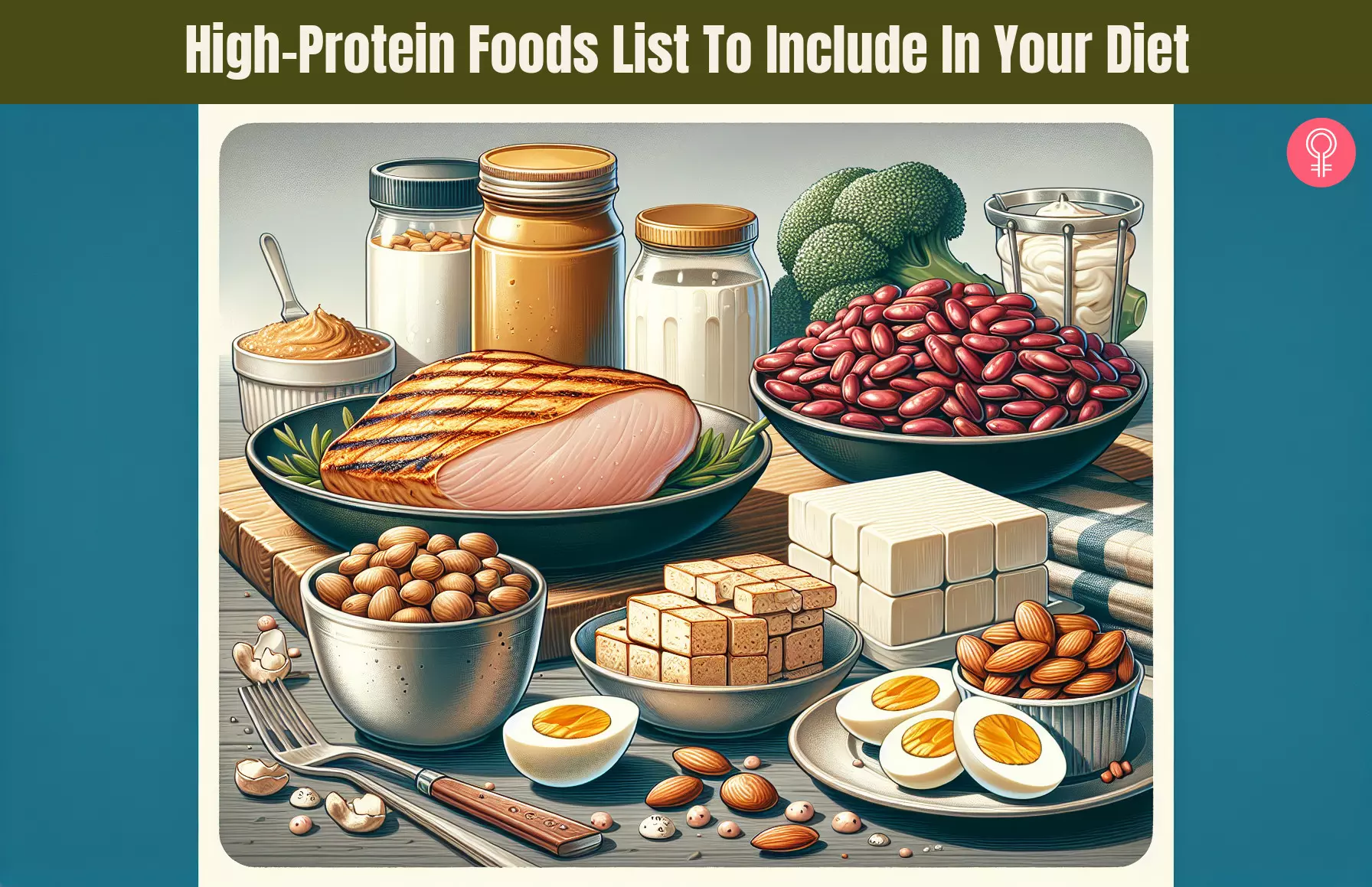
Image: Dall·E/StyleCraze Design Team
Learn about the highest protein foods in the world and how to incorporate them into your diet for the best health and nutrition. Check this video to know more.
Personal Experience: Source
StyleCraze's articles are interwoven with authentic personal narratives that provide depth and resonance to our content. Below are the sources of the personal accounts referenced in this article.
i. How I lost 43lbshttps://www.ybrikman.com/writing/2008/12/17/introduction-my-bodyweight-during-2008/
References
Articles on StyleCraze are backed by verified information from peer-reviewed and academic research papers, reputed organizations, research institutions, and medical associations to ensure accuracy and relevance. Read our editorial policy to learn more.
- The satiating effects of eggs or cottage cheese are similar in healthy subjects despite differences in postprandial kinetics
https://pubmed.ncbi.nlm.nih.gov/25772196/ - Effects of Egg White Protein Supplementation on Muscle Strength and Serum Free Amino Acid Concentrations
https://www.ncbi.nlm.nih.gov/pmc/articles/PMC3497008/ - Effects of Dietary Yogurt on the Healthy Human Gastrointestinal (GI) Microbiome
https://www.ncbi.nlm.nih.gov/pmc/articles/PMC5374383/ - Soy milk and Dairy Consumption are Independently Associated with Ultrasound Attenuation of the Heel bone among Postmenopausal Women: The Adventist Health Study-2 (AHS-2)
https://www.ncbi.nlm.nih.gov/pmc/articles/PMC3218100/ - A Contribution of Beef to Human Health: A Review of the Role of the Animal Production Systems
https://www.ncbi.nlm.nih.gov/pmc/articles/PMC4771914/ - Role of poultry meat in a balanced diet aimed at maintaining health and wellbeing: an Italian consensus document
https://www.ncbi.nlm.nih.gov/pmc/articles/PMC4462824/ - Health Benefits of Fish
https://doh.wa.gov/community-and-environment/food/fish/health-benefits - Health Benefits of Nut Consumption
https://www.ncbi.nlm.nih.gov/pmc/articles/PMC3257681/ - Pistachios for Health
https://www.ncbi.nlm.nih.gov/pmc/articles/PMC4890834/ - Health benefits of almonds beyond cholesterol reduction
https://pubmed.ncbi.nlm.nih.gov/22296169/ - Role of walnuts in maintaining brain health with age
https://pubmed.ncbi.nlm.nih.gov/24500933/ - A Pecan-Rich Diet Improves Cardiometabolic Risk Factors in Overweight and Obese Adults: A Randomized Controlled Trial
https://www.ncbi.nlm.nih.gov/pmc/articles/PMC5872757/ - Magnesium basics
https://www.ncbi.nlm.nih.gov/pmc/articles/PMC4455825/ - Chia Seeds (Salvia Hispanica L.): An Overview—Phytochemical Profile, Isolation Methods, and Application
https://www.ncbi.nlm.nih.gov/pmc/articles/PMC6994964/ - The future of oats in the food and health continuum
https://pubmed.ncbi.nlm.nih.gov/25267248/ - Review of the health benefits of peas (Pisum sativum L.)
https://pubmed.ncbi.nlm.nih.gov/22916813/ - Retraction Notice To: Potential Health Benefits of Broccoli- A Chemico-Biological Overview
https://pubmed.ncbi.nlm.nih.gov/19/ - Hass Avocado Composition and Potential Health Effects
https://www.ncbi.nlm.nih.gov/pmc/articles/PMC3664913/ - Dietary protein intake and human health
https://pubs.rsc.org/en/content/articlehtml/2016/fo/c5fo01530h
Read full bio of Alexandra Dusenberry
Read full bio of Ravi Teja Tadimalla
Read full bio of Arshiya Syeda
Read full bio of Aparna Mallampalli







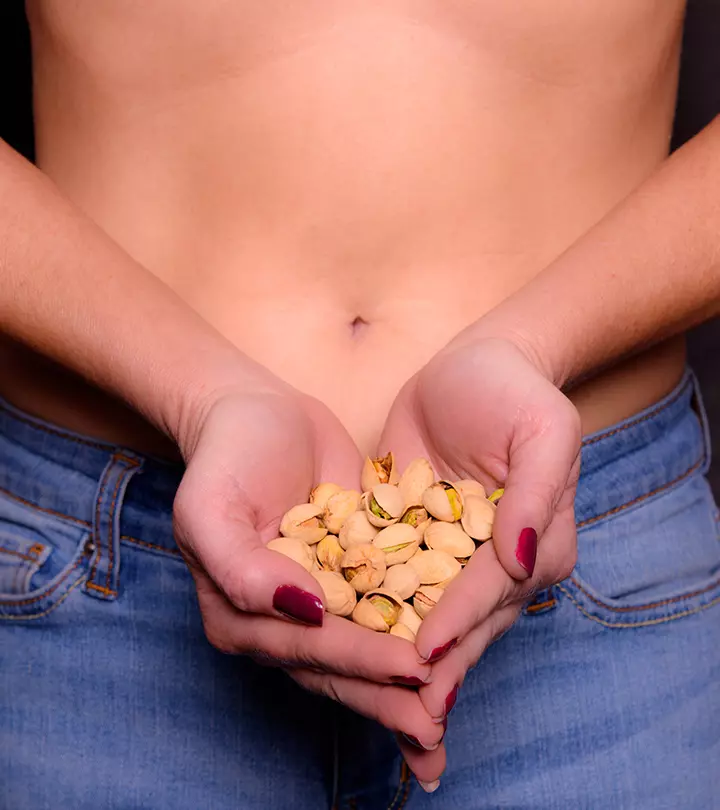
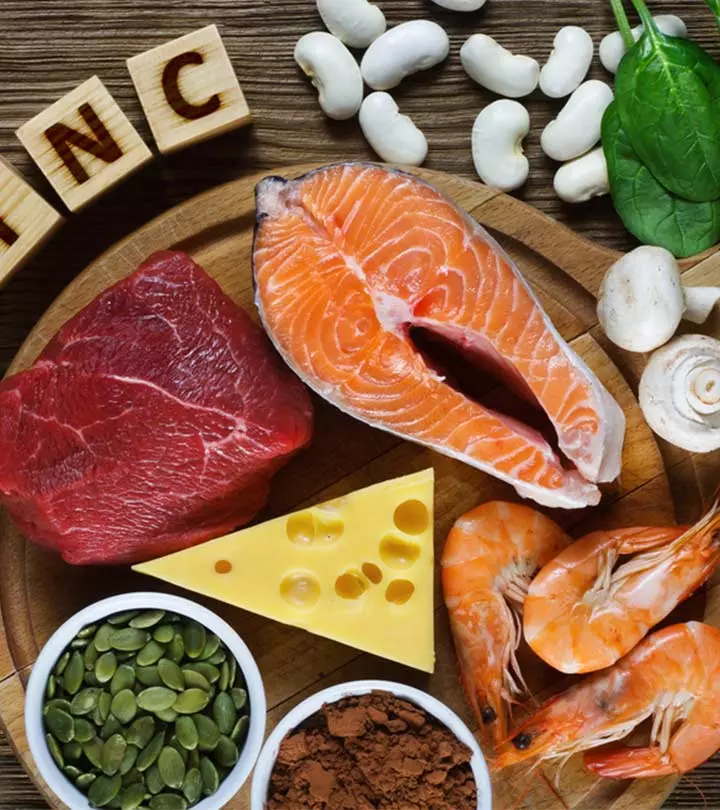
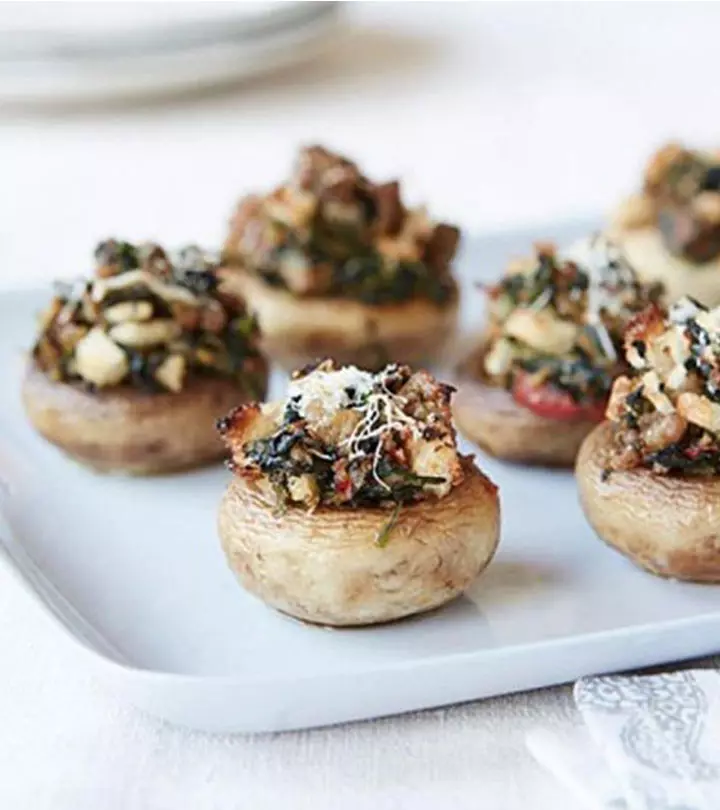
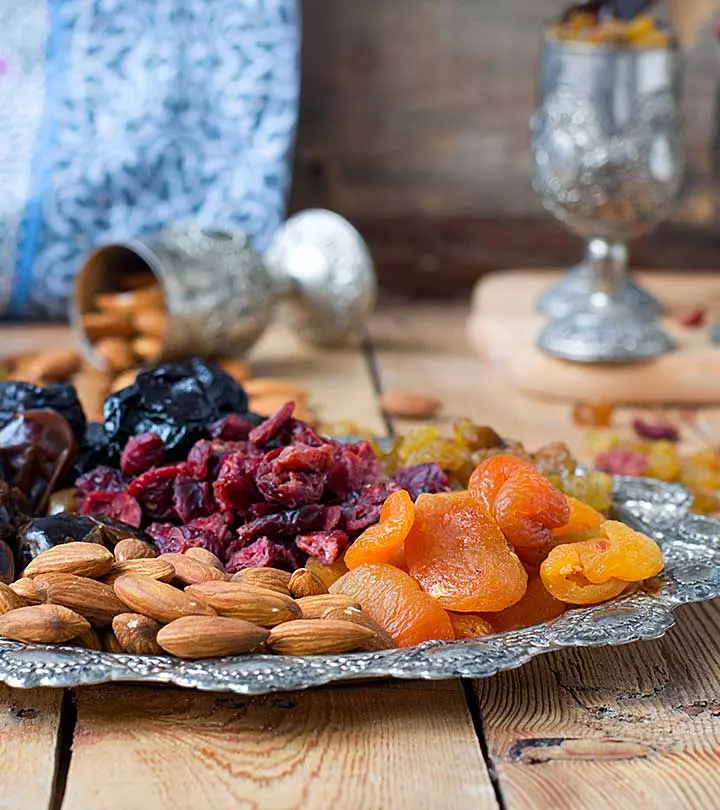
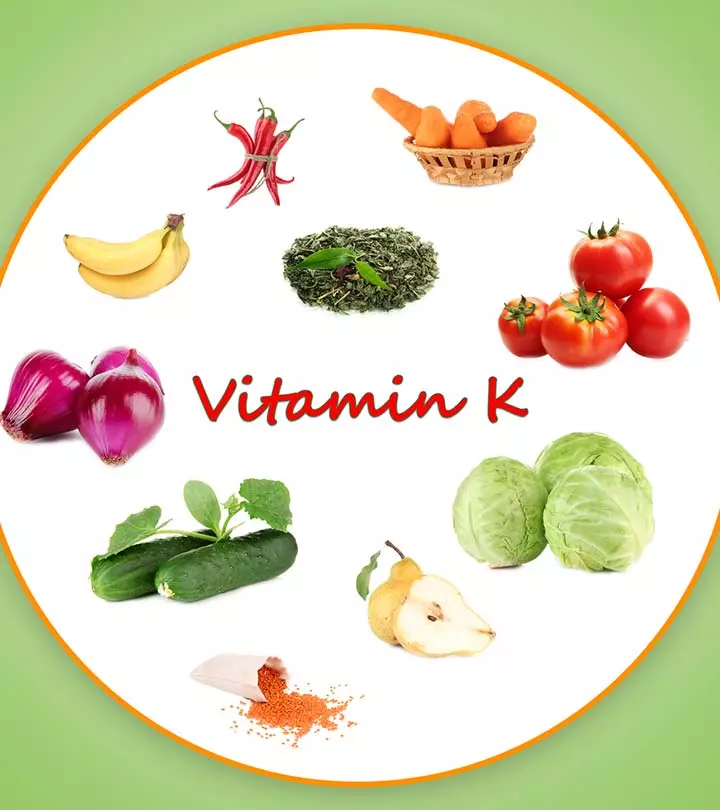
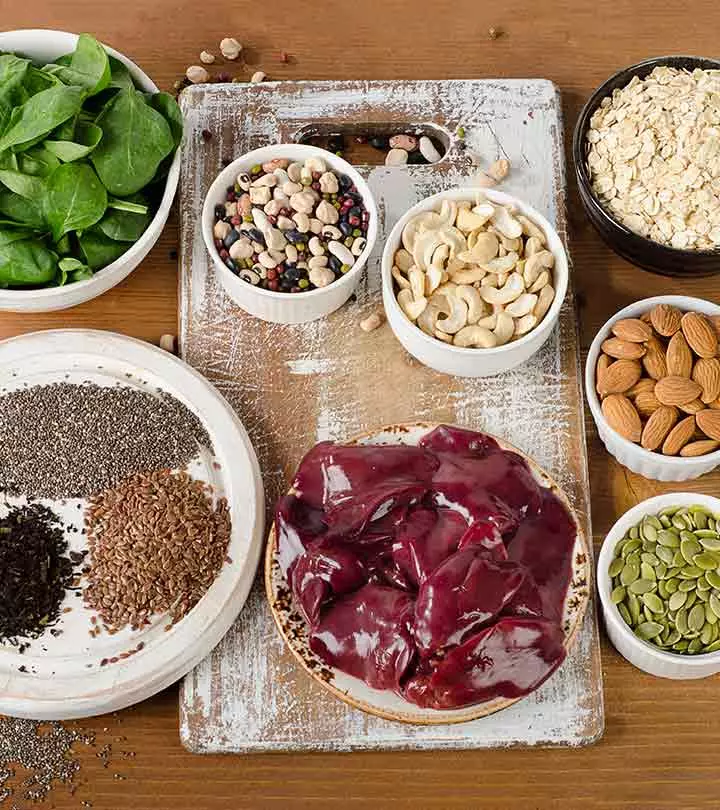
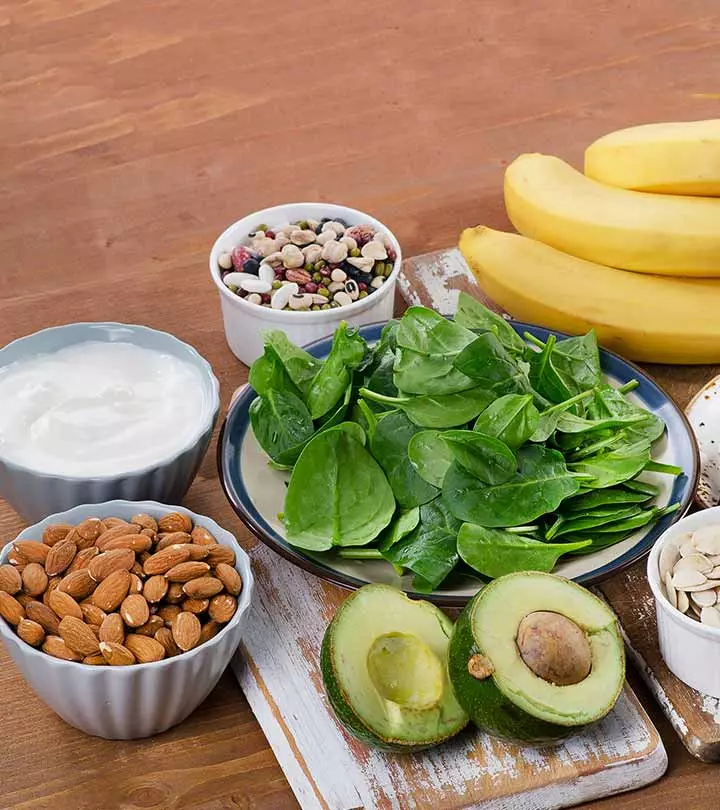
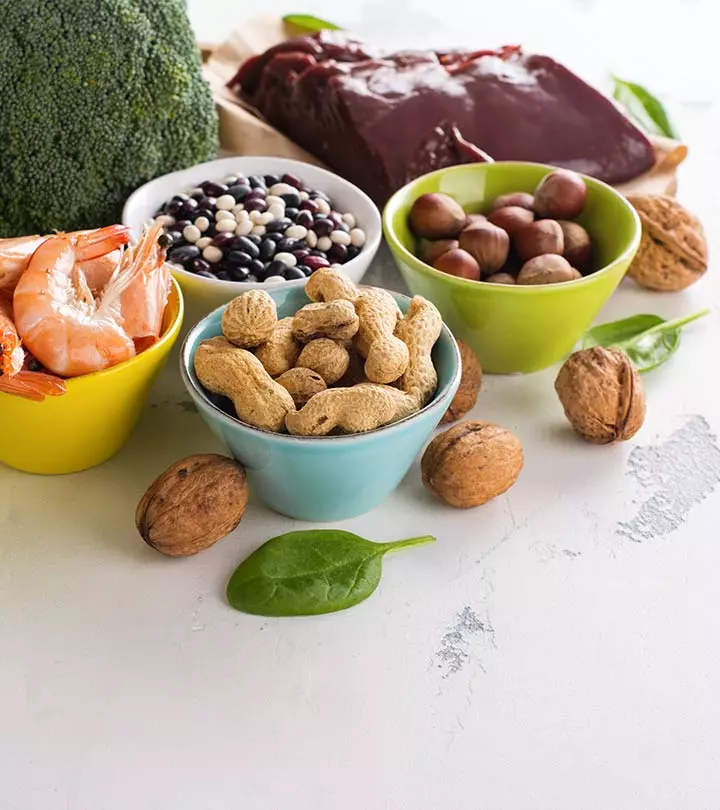
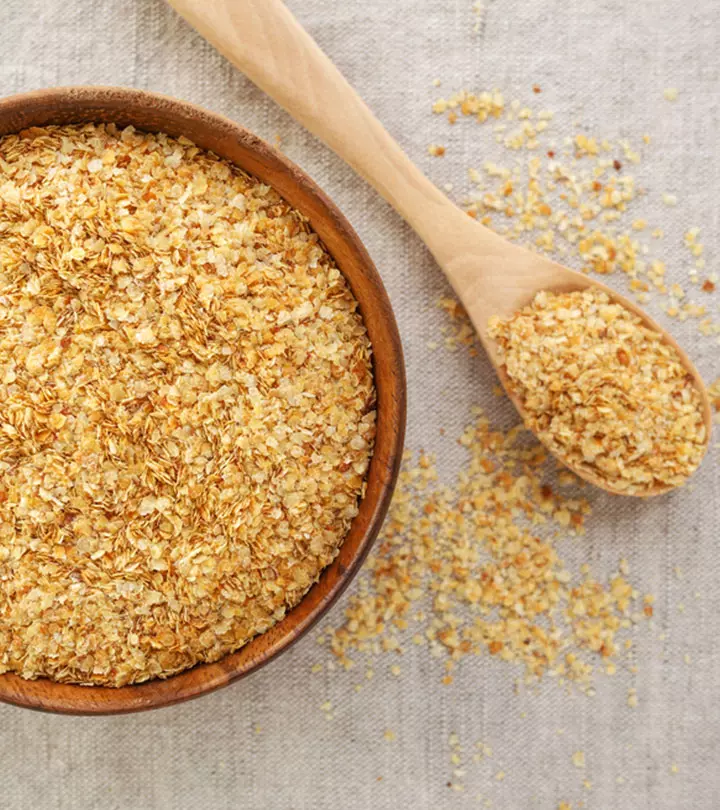
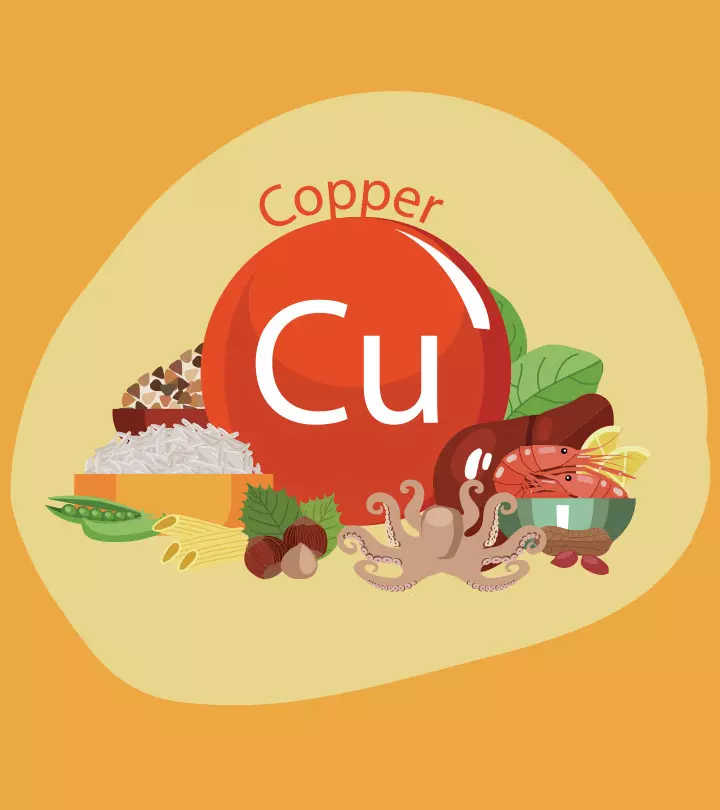
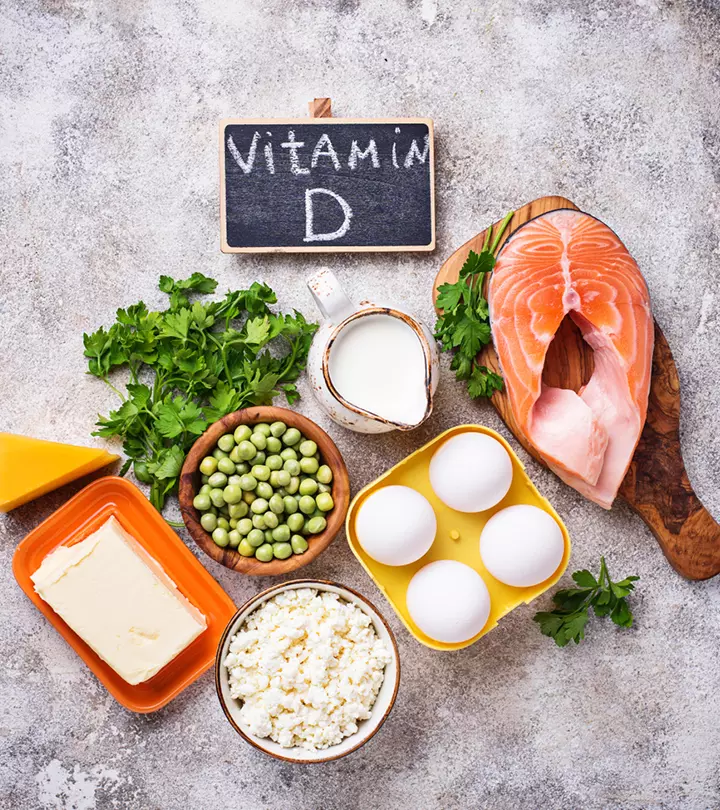
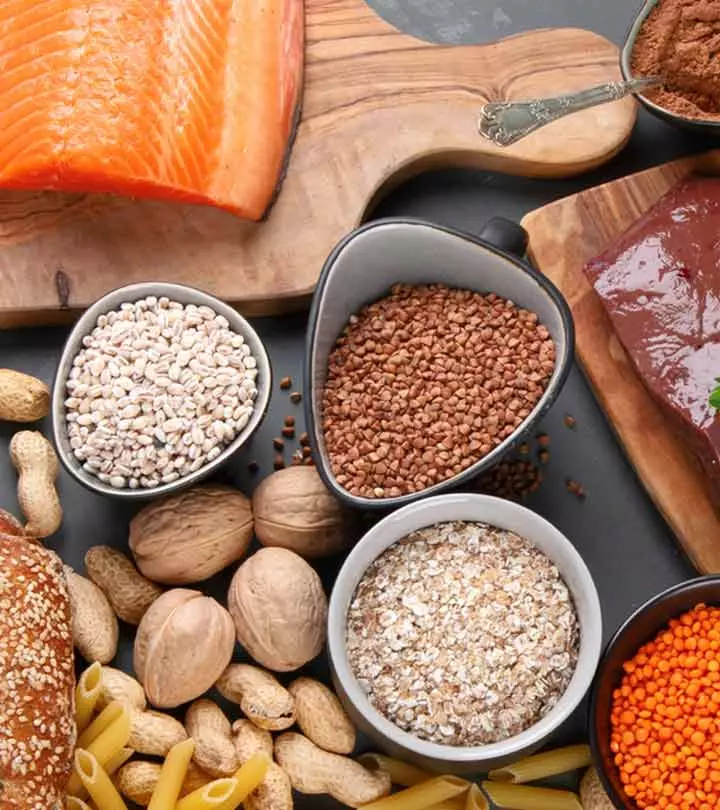

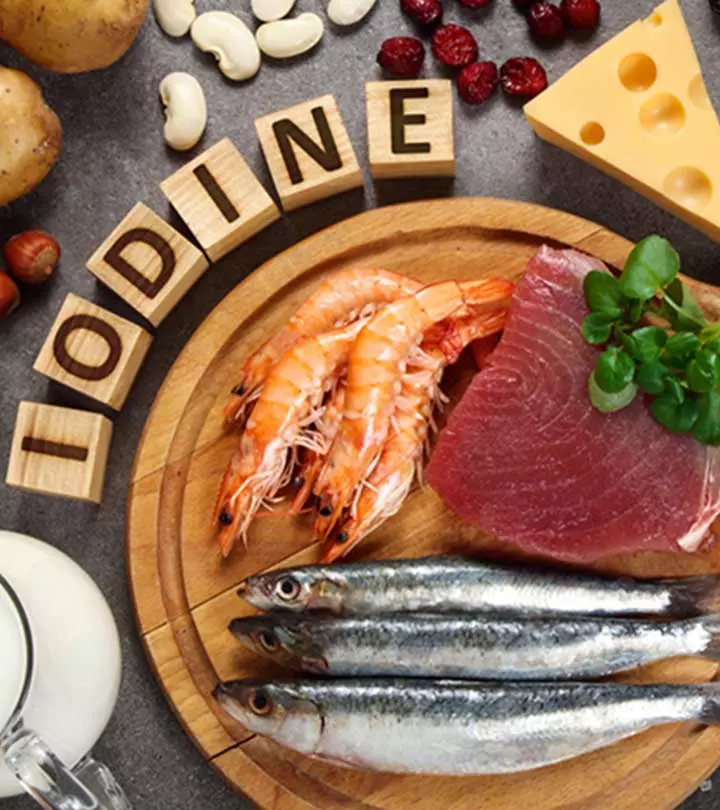

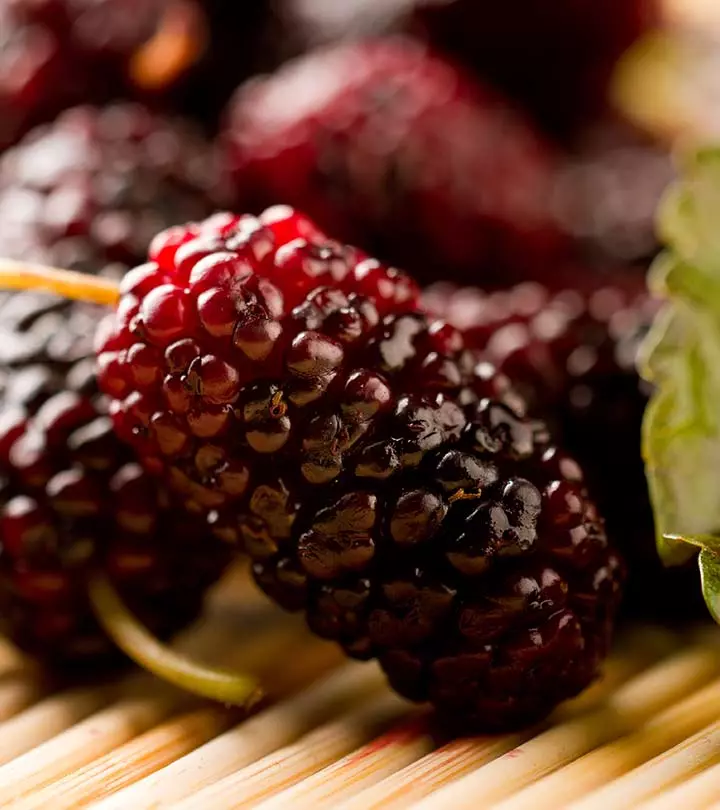
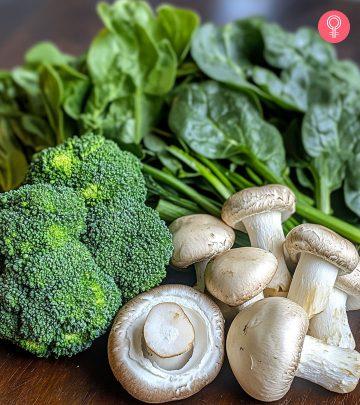
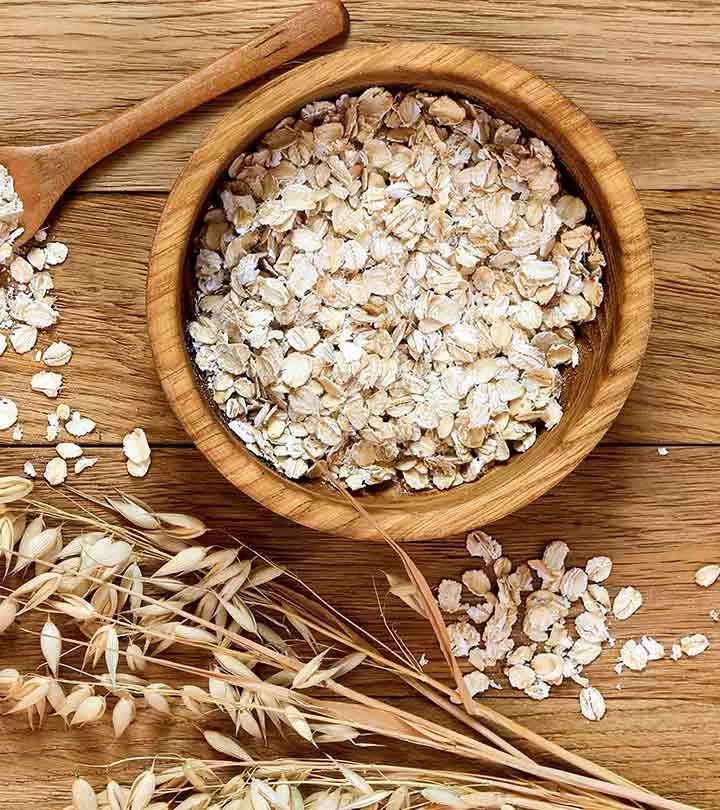
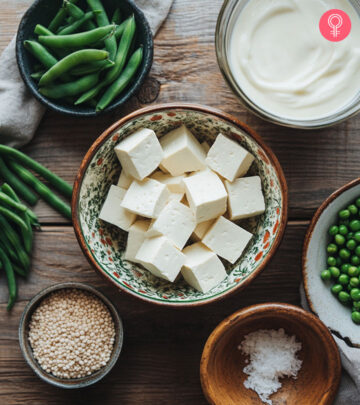

Community Experiences
Join the conversation and become a part of our empowering community! Share your stories, experiences, and insights to connect with other beauty, lifestyle, and health enthusiasts.